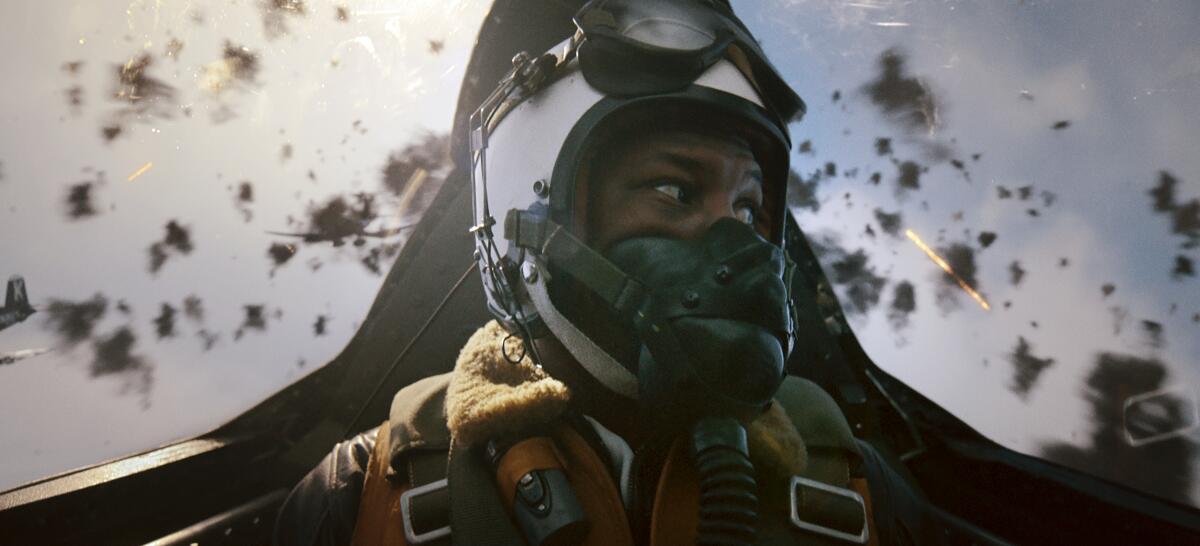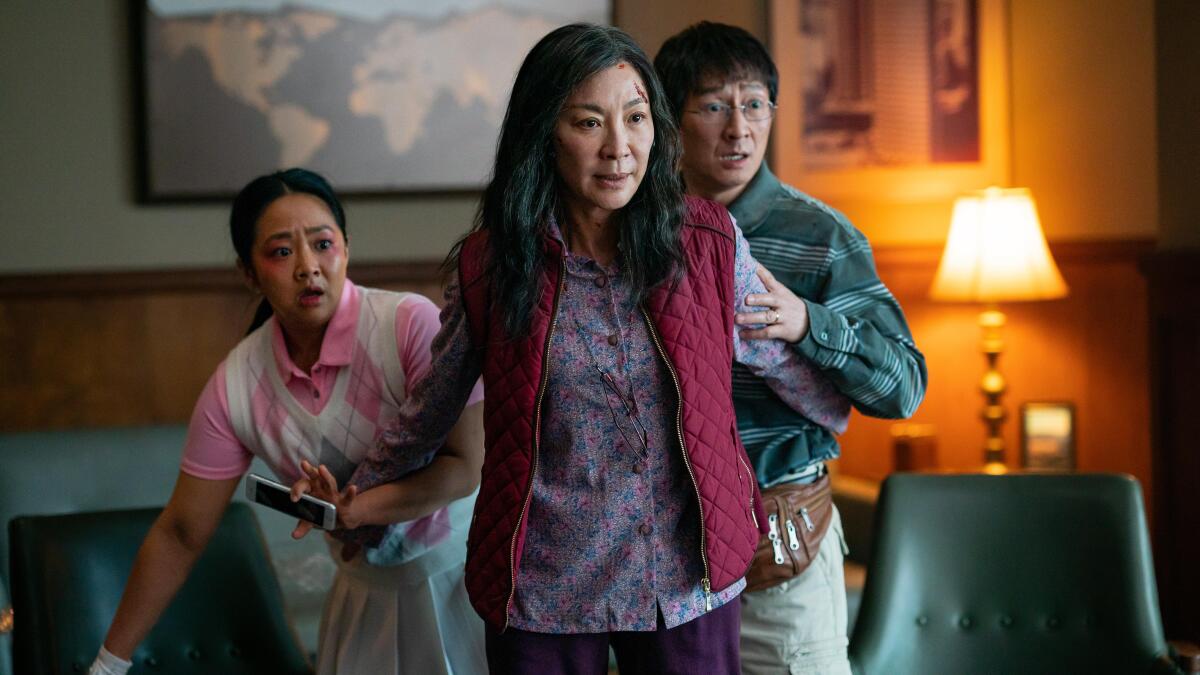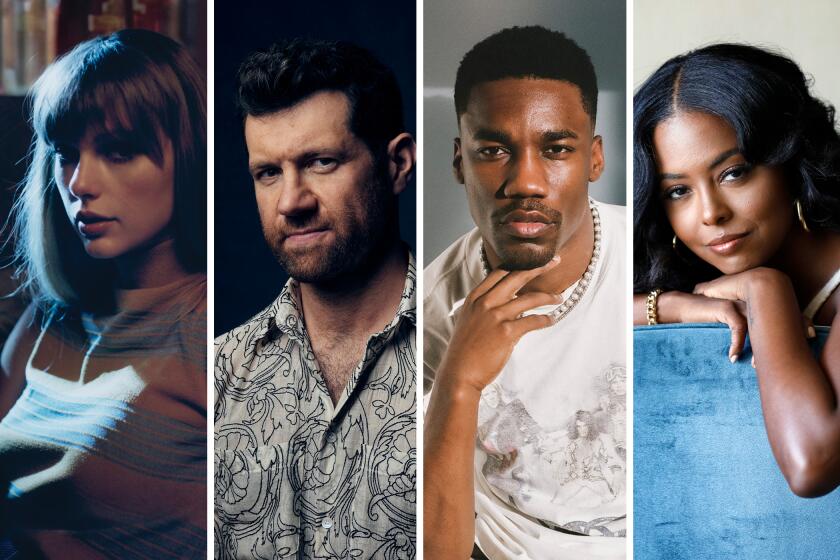These songs consider loneliness, connectedness and a wild dance-off

- Share via
Among the many movies sporting Oscar-contending original songs are three that stand out in different ways. The moods among them include a frenetic dance number, a haunting melody for anyone separated from loved ones and ... a nod to quantum physics.

“Naatu Naatu” from “RRR”
So you just saw the Indian smash “RRR” and think you may be possessed. A mysterious force is making you attempt some extraordinarily masculine kick-dancing — Riverdance on super-soldier serum. Blame composer M.M. Keeravani, who, with lyricist Chandrabose, concocted the movie’s fiendish earworm, “Naatu Naatu.”
“The chorus line, that’s the catchy phrase,” says Keeravani, singing the droning hook: “ ‘Naa-tu, naatu naatu naatu naatu naatu veera, Naa-tu.’ I was asked to do a catchy number that would be an aggressive dance. My job was very simple. It will stick.”
Keeravani says that in India’s Telugu language, “the exact meaning of ‘naatu’ is ‘country’ — it’s country music. It’s a genre. ‘I don’t want jazz, I don’t want classical; I don’t want anything but country, country, country, country.’ ”
A showdown in the epically macho bromance sparks a high-stakes dance-off. “The backbone is the beat — we call it ‘duff.’ That instrument: ‘Dahng dahng da daka da daka da dahng da daka da daka da’. That’s the pulse of this song. The bass pattern, any other instruments, like the flutes — they take the back seat. Only rhythm is going to take the front seat.”
The song has taken off internationally, with students and others posting videos online of their versions of the dance (Keeravani cites one of American college kids’ that he particularly enjoys). Why has this Bollywood song resonated with so many? It might be the unbridled energy and joy in the film’s sequence.

“Not Alone” from “Devotion”
“Not Alone” may not be what Joe Jonas fans expect — certainly not the brightly colored pop of the Jonas Brothers (“Sucker” it ain’t). Rather, the collaboration by him, Ryan Tedder of OneRepublic, Bernard Harvey (AKA “Harv”) and Khalid builds from a bare, insistent pattern of piano chords sounding in the great, wide open. It’s spare and lonely. Jonas’ vocal is simple, rougher than usual. Droning voices rise in the background, behind a rumble in the bass suggesting an engine. It’s easy to imagine being in a cockpit en route to a fateful mission, the solo pilot trying to send a message to his wife and child by pure will.
“J.D. wanted something that captured the raw emotion of where the film ends,” Jonas said of writer-director J.D. Dillard’s request for a song for the Korean War drama “Devotion.” Jonas also acts in the film as a squad-mate of Ensign Jesse L. Brown (played by Jonathan Majors), America’s first Black naval aviator.
“I was really moved by the letters Jesse wrote [his wife] Daisy. They spoke to some of the hope, some of the love, this relationship they had, this bond, even though he couldn’t physically be there for her and for their daughter at times,” says Jonas. “If he were to write this song, what would he say?”
The song’s melody bears the pop influences of its creators, but its texture is something different — more adult, more emotional, not geared toward radio.
“Every little part of the song was really thought through. Those haunting four chords that repeat and repeat, we wanted that to feel like a military band or something ghostly, haunting.
“After the song was done,” Jonas says, “I was just hit with a wave of emotion. I’m in the studio crying because of the storytelling, but also the journey to get here, to that place and to feel so connected to this work.”
Taylor Swift, Lady Gaga, Selena Gomez and J. Lo are among the well-known artists all over this year’s Oscars original song contenders playlist.

“This Is a Life” from “Everything Everywhere All at Once”
”Everything Everywhere All at Once” is a heady multiversal brew that bends alternate realities through martial-arts madness to reinvigorate a family. Which makes the title of its end-credits song by soundtrack composers Son Lux, noted singer-songwriter Mitski and Rock and Roll Hall of Famer David Byrne apropos: “This Is a Life.”
Son Lux guitarist Rafiq Bhatia explains the idea: “With all of the possibilities of life in front of us, we choose to be here, doing what we’re doing in the midst of each other.”
“This is a life,” Mitski sings dreamily in the song, with Byrne’s soothing voice threading in with “every possibility.” It’s a conversation continued from another universe. “Free from destiny,” she continues; “I choose you, and you choose me,” he responds.
After seeing a rough cut of the film, Byrne’s feedback to its directors and Son Lux was “If you could do a song at the end that reminds people how much heart there is in this show — because they’re gonna be thinking, ‘Oh, my God, my mind is blown, all this craziness, what dimension are we in?’ — to bring it back to the emotional center, how actually moving it is and tag that in the song ....
“I think the guys kind of did that,” Byrne continues. “They said, ‘We’re gonna send this to Mitski; she’s gonna record her vocal, and you have to figure out how to work your vocal around hers.’ So I wrote extra words responding to what she was singing, tried to do counter melodies, and then of course added harmonies, so it became like a little dialogue.”
At first, Mitski’s vocals take the lead and Byrne responds; later, he takes the lead and she responds. Around this, they intertwine and harmonize.
Apart from what Son Lux (founder Ryan Lott, Bhatia and percussionist Ian Chang) had in place, Mitski made adjustments such as incorporating a line of dialogue from the film that actress Stephanie Hsu sang instead of speaking: “Sucked ... into ... a ba-a-agel.” Lott says, “I loved that Mitski picked up on that moment and found a way to use that melody and those words as a background vocal in a special moment in the song.”
Lott points out the song doesn’t follow the common verse-chorus structure but feels as if it’s in two distinct parts separated by that “bagel” moment: “It feels noncyclical and nonlinear.”
As to the flights of fancy the multiverse tale enjoys, Byrne considers some of the ideas in quantum physics that bend his mind and says, “It makes you think the universe is more like a web, a network, an entangled thing. It’s an entangled web of relationships between all these particles and therefore bigger things, cosmic bodies and life forms and everything else. And we’re all somehow, in a kind of cosmic way, connected. I use the word ‘entanglement’ in the song; I intentionally use these terms from quantum physics in the sense of a relationship.”
Perhaps the ideas are expressed no more pithily than in the song’s final words: “This is a life / This is our life.”
As Byrne says, “It’s not a song that smacks you over the head, but if you listen to it, it’s quite beautiful.”
More to Read
From the Oscars to the Emmys.
Get the Envelope newsletter for exclusive awards season coverage, behind-the-scenes stories from the Envelope podcast and columnist Glenn Whipp’s must-read analysis.
You may occasionally receive promotional content from the Los Angeles Times.












